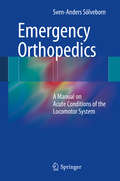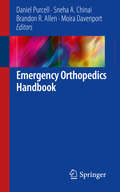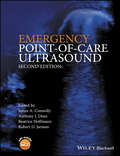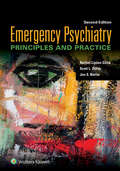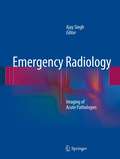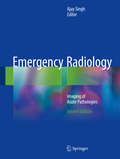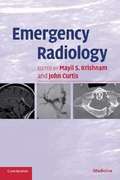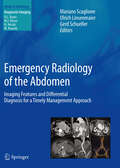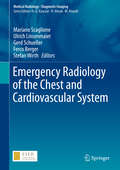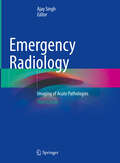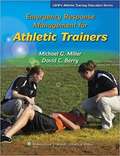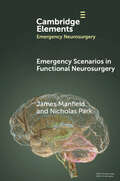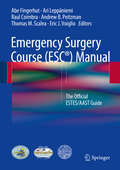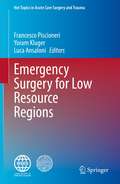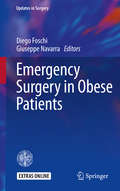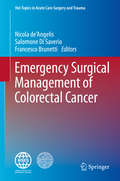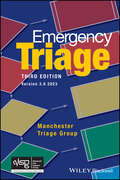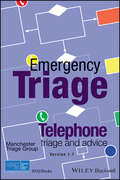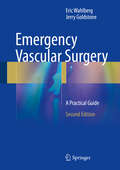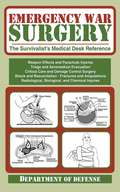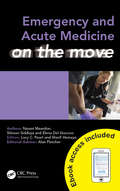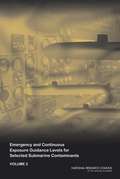- Table View
- List View
Emergency Orthopedics
by Sven-Anders SölvebornEmergency Orthopedics is a practical, up-to-date, and comprehensive manual on the diagnosis and treatment of emergency injuries and disorders of the locomotor system. Its problem-based structure, with each chapter addressing a particular symptom, is designed to allow the reader to rapidly locate hands-on advice. For each symptom, facts and findings that will assist in diagnosis are highlighted. Possible diagnoses are suggested according to the ICD-10 code, and the proposed treatment recommendations consider both short- and long-term aspects. The text is supported by exceptionally instructive illustrations, e. g. , of examination techniques and reduction maneuvers. The author has extensive practical experience in emergency rooms as well as in sports medicine, research, and education. This book will be a treasure trove of information for all who work in the emergency room and will also be very useful for general practitioners, physiotherapists, and chiropractors.
Emergency Orthopedics Handbook
by Brandon R. Allen Daniel Purcell Sneha A. Chinai Moira DavenportThis handbook provides a comprehensive, yet succinct guide to the evaluation, diagnosis, and treatment of various musculoskeletal/extremity disorders in the emergency department. It covers a wide variety of common patient presentations, advanced imaging interpretation, proper anesthetic implementation, and associated extremity reduction/immobilization techniques. Richly illustrated, it assists clinical decision making with high-yield facts, essential figures, and step-by-step procedural instruction. Emergency Orthopedics Handbook is an indispensable resource for all medical professionals that manage emergent orthopedic, musculoskeletal, and local extremity injury care.
Emergency Point-of-Care Ultrasound
by Anthony J. Dean Beatrice Hoffmann James A. Connolly Robert D. JarmanFeaturing contributions from internationally recognized experts in point-of-care sonography, Emergency Point-of-Care Ultrasound, Second Edition combines a wealth of images with clear, succinct text to help beginners, as well as experienced sonographers, develop and refine their sonography skills. The book contains chapters devoted to scanning the chest, abdomen, head and neck, and extremities, as well as paediatric evaluations, ultrasound-guided vascular access, and more. An entire section is devoted to the syndromic approach for an array of symptoms and patient populations, including chest and abdominal pain, respiratory distress, HIV and TB coinfected patients, and pregnant patients. Also included is expert guidance on administering ultrasound in a variety of challenging environments, such as communities and regions with underdeveloped healthcare systems, hostile environments, and cyberspace. Each chapter begins with an introduction to the focused scan under discussion and a detailed description of methods for obtaining useful images. This is followed by examples of normal and abnormal scans, along with discussions of potential pitfalls of the technique, valuable insights from experienced users, and summaries of the most up-to-date evidence. Emergency Point-of-Care Ultrasound, Second Edition is a valuable working resource for emergency medicine residents and trainees, practitioners who are just bringing ultrasound scanning into their practices, and clinicians with many years of sonographic experience.
Emergency Psychiatry
by Arjun Chanmugam Mba Patrick Triplett Gabor Kelen Patrick TriplettMany healthcare providers based in primary care, emergency care or other acute care environments encounter patients with psychiatric problems. These presentations can be difficult to manage and often pose significant challenges. A better understanding of most common psychiatric problems can greatly aid both providers and patients. Emergency Psychiatry reviews a wide range of common psychiatric disorders and provides succinct management guidelines. Written by emergency physicians and psychiatrists, Emergency Psychiatry is a rapid reference for the acute management of psychiatric disorders for all care providers, including, but not limited to, emergency physicians, internists, psychiatrists, social workers, family practitioners and other primary care providers.
Emergency Psychiatry: Principles And Practice
by Rachel Lipson Glick Jon S. Berlin Avrim Fishkind Scott L. ZellerThe field of emergency psychiatry is complex and varied, encompassing elements of general medicine, emergency medicine, trauma, acute care, the legal system, politics and bureaucracy, mental illness, substance abuse and addiction, current social issues, and more. In one comprehensive, highly regarded volume, Emergency Psychiatry: Principles and Practice brings together key principles from psychiatric subspecialties as well as from emergency medicine, psychology, law, medical ethics, and public health policy. Leading emergency psychiatrists write from their extensive clinical experience, providing evidence-based information, expert opinions, American Psychiatric Association guidelines, and case studies throughout the text. This fully up-to-date second edition covers all of the important issues facing psychiatry residents and practitioners working in today’s emergency settings, or who encounter psychiatric emergencies in other medical settings.
Emergency Radiology
by Ajay SinghIn the emergency and trauma setting, accurate and consistent interpretation of imaging studies are critical to the care of acutely ill and injured patients. Emergency Radiology: Imaging of Acute Pathologies is a comprehensive review of radiological diagnoses commonly encountered in the emergency room by radiologists, residents, and fellows. The book is organized by anatomical sections that present the primary ER imaging areas of the acute abdomen, pelvis, thorax, neck, head, brain and spine, and osseous structures. For each section, the common diagnoses are concisely described and are accompanied by relevant clinical facts and key teaching points that emphasize the importance of radiological interpretation in clinical patient management. The role of modalities such as plain radiography, CT, ultrasound, MR, and nuclear medicine imaging in managing emergency conditions is highlighted.
Emergency Radiology
by Ajay SinghIn the emergency and trauma setting, accurate and consistent interpretation of imaging studies are critical to the care of acutely ill and injured patients. Emergency Radiology: Imaging of Acute Pathologies is a comprehensive review of radiological diagnoses commonly encountered in the emergency room by radiologists, residents, and fellows. The book is organized by anatomical sections that present the primary ER imaging areas of the acute abdomen, pelvis, thorax, neck, head, brain and spine, and osseous structures. For each section, the common diagnoses are concisely described and are accompanied by relevant clinical facts and key teaching points that emphasize the importance of radiological interpretation in clinical patient management. The role of modalities such as plain radiography, CT, ultrasound, MR, and nuclear medicine imaging in managing emergency conditions is highlighted.
Emergency Radiology
by John Curtis Mayil S. KrishnamEmergency Radiology is a quick reference pocketbook for radiologists worldwide working in any emergency or acute care setting. It acts both as a checklist of presenting features to enable accurate interpretation of diagnostic imaging investigations and as a guide to understanding the basics of performing therapeutic or diagnostic interventional procedures. A wide range of emergencies are reviewed, giving all pertinent information in a concise presentation for on-call radiologists and trainees who encounter these emergencies out-of-hours. The text is complemented by high quality images of emergency conditions in all body systems, including head, cardiovascular, chest, abdomen, pelvis and extremities. Pediatrics, fluoroscopy, ultrasound and the use of MRI in emergencies are also discussed. Emergency Radiology is an invaluable for all radiologists, emergency physicians and radiography technicians, as well as for any healthcare practitioner involved in patient care in the emergency or acute care environment.
Emergency Radiology COFFEE Case Book
by Jacob Mandell Khurana, Bharti and Mandell, Jacob and Sarma, Asha and Ledbetter, Stephen Bharti Khurana Asha Sarma Stephen LedbetterEmergency radiology requires consistent, timely, and accurate imaging interpretation with the rapid application of clinical knowledge across many areas of radiology practice that have traditionally been fragmented by organ system or modality divisions. This text unifies this body of knowledge into an educational resource capturing the core competencies required of an emergency radiologist. This book of 85 index cases is organized by clinical presentations that simulate real-life radiology practice in the emergency department. Companion cases spanning the differential diagnoses and spectrum of disease provide hundreds more examples for a fast, focused and effective education called COFFEE (Case-Oriented Fast Focused Effective Education). This text can serve as a 'go to' resource for radiologists, as well as any other physicians working in the emergency department. It will be an excellent companion for radiologists preparing for initial board certification or re-certification by the American Board of Radiology.
Emergency Radiology of the Abdomen
by Gerd Schueller Mariano Scaglione Ulrich LinsenmaierThe term "acute abdomen" refers to a serious, often progressive clinical situation that calls for immediate diagnostic and therapeutic action. Today, diagnosis via imaging has basically replaced the physical examination in the emergency room and the Radiologist has become of primary importance in this setting. However, close co-operation among the various specialists involved is essential for successful patient management, and thus the Radiologist needs to have a full understanding of the imaging modalities and technical skills required, as well as appropriate clinical knowledge of the disorder in order to manage the condition. This book provides a comprehensive review of the multifaceted etiology, pathophysiology and clinical presentation of acute abdominal conditions, focusing on the imaging features that are relevant to a timely management approach. Numerous high-quality images, diagrams and easy-to-read tables are provided.
Emergency Radiology of the Chest and Cardiovascular System
by Gerd Schueller Mariano Scaglione Ulrich Linsenmaier Ferco Berger Stefan WirthThis book provides an up-to-date, systematic review of all facets of emergency radiology in patients with chest trauma or pain with the aim of equipping the reader with a detailed knowledge of the various radiological patterns, which is essential in order to make a prompt diagnosis under circumstances when time is of critical importance. To this end, the indications, value, and results of the various emergency imaging modalities, including sonography and interventional radiology, are described and illustrated in the full range of blunt chest injuries and nontraumatic chest emergencies. Technological aspects, protocols tailored to the mechanism of injury, and post-processing techniques are also extensively covered. Emergency Radiology of the Chest and Cardiovascular System will be of value to general and interventional radiologists, radiology residents, radiology technicians, and all physicians and surgeons who work in emergency care.
Emergency Radiology: Imaging of Acute Pathologies
by Ajay SinghThis book offers a comprehensive review of acute pathologies commonly encountered in the emergency room as diagnosed by radiologic imaging. In the emergency and trauma setting, accurate and consistent interpretation of imaging studies are critical to the care of acutely ill and injured patients. To aid readers, chapters are organized by anatomical sections that present the primary ER imaging areas of the acute abdomen, pelvis, thorax, neck, head, brain and spine, and osseous structures. For each section, the common diagnoses are concisely described and are accompanied by relevant clinical facts and key teaching points that emphasize the importance of radiologic interpretation in clinical patient management. The role of modalities such as plain radiography, computed tomography, ultrasound, magnetic resonance imaging, and nuclear medicine imaging in managing emergency conditions is highlighted. The third edition is thoroughly updated and includes over 750 images and multiple choice questions in each chapter. Two additional chapters have also been added: plain x-ray imaging findings and 50 imaging signs in emergency radiology. Emphasizing the core concepts in emergency radiology, this book is a valuable resource for radiologists, residents, and fellows.
Emergency Response Management For Athletic Trainers
by Michael Miller David BerryWritten specifically for athletic trainers and students, this comprehensive text will teach readers how to quickly and effectively assess and manage the broad range of medical emergencies that athletes may experience, including traumatic injuries, respiratory and circulatory arrest, and sudden illness. It not only explains core first aid skills, but it also highlights the specific athletic training emergency trauma skills outlined in the educational competencies set by the National Athletic Trainer's Association Board of Certification. <p><p> Within each chapter, readers will find a mix of theory and practical, hands-on guidance to help them perform essential emergency response techniques. Moreover, each chapter has been designed to account for different learning styles, incorporating a variety of didactic, visual, and kinesthetic learning tools to enable everyone to master the core skills of emergency response management.
Emergency Scenarios in Functional Neurosurgery (Elements in Emergency Neurosurgery)
by James Manfield Nicolas ParkFunctional Neurosurgery modifies CNS circuits to effect change within or outside the nervous system. Most commonly, Functional procedures are performed to treat movement disorders, chronic pain, spasticity and epilepsy. Whilst regarded as a predominantly elective subspecialty, emergent scenarios are encountered. The combination of their relative rarity couple with the niche nature of the subspecialty may engender anxiety amongst neurosurgery trainees. This Element overviews some more common emergency scenarios which may be encountered comprising suspected malfunction of intra-thecal drug delivery devices, deep brain and spinal cord stimulators. Status Trigeminus and an approach to investigations with a neuromodulation device in situ are also covered.
Emergency Surgery Course (ESC®) Manual
by Abe Fingerhut Ari Leppäniemi Raul Coimbra Andrew B. Peitzman Thomas M. Scalea Eric J. VoiglioThis manual explains how to make the right decisions on the timing and selection of investigations and surgical procedures in emergency and urgent surgical settings and describes the most widely used procedures step by step with the aid of high-quality illustrations. The goal is to address the situations that can arise in almost any emergency department throughout the world, enabling the surgeon on call to acquire or sharpen the knowledge and skills needed to deal with acute surgical problems in the most appropriate way. The reader will gain a sound understanding of the most efficient diagnostic modalities, pre-, intra-, and postoperative decision-making, and surgical techniques and issues in particular circumstances. The manual stems from an initiative by members of the European Society of Trauma and Emergency Surgery (ESTES) and the American Association for the Surgery of Trauma (AAST) to set up and formalize Emergency Surgery Courses to provide specific training in emergency and acute care surgery. It represents a didactic accompaniment to the course that will guide the beginner and maintain a certain degree of standardization among the more experienced.
Emergency Surgery for Low Resource Regions (Hot Topics in Acute Care Surgery and Trauma)
by Luca Ansaloni Yoram Kluger Francesco PiscioneriThis book is aimed at surgeons faced with the immediate management of acute surgical problems in a variety of resource settings. The topics covered are common in both developed and developing countries as well as in tropical and non-tropical settings. The book offers an introduction to trauma, which includes primary, secondary and tertiary surveys, trauma resuscitation, and multidisciplinary care followed by a short section on acute burns management and a discussion of a range of specific surgical topics including various of acute abdomen, upper and lower gastrointestinal bleeding, perianal conditions, oncological issues that require acute intervention, abdominal wall problems, urological emergencies and neck swellings. It also addresses the rational use of antibiotics and medications and the role of high dependency units. Each chapter includes a flow chart algorithm with multiple endpoints that relate to the resource situations available to the surgeon. The book is of interest to clinicians dealing with changes in acute surgery and the increasing disparity between developed and developing countries
Emergency Surgery in Obese Patients (Updates in Surgery)
by Diego Foschi Giuseppe NavarraThis comprehensive, multi-authored book covers all aspects of surgery on obese patients in emergency conditions. Obesity is a metabolic disease affecting a high percentage of world population.. It involves marked anthropometric changes, affecting surgical practice and altering patients’ ability to react to surgical stress. The prevalent comorbidities also affect the rate of complications and mortality after surgery. The obesity paradox, the ability of obese patients to survive emergency operations in spite of an increased risk of complications, is an effect of the widespread development of “Obesity Science”. This volume discusses this science, examining the frailty of the obese patients and the main comorbidities that affect clinical practice, as well as the most frequent emergency situations after trauma, inflammatory diseases and the complications of bariatric surgery.With contributions from leading experts, it provides clinicians with detailed and updated information for better practice in this emerging field of surgery.
Emergency Surgical Management of Colorectal Cancer (Hot Topics in Acute Care Surgery and Trauma)
by Salomone Di Saverio Nicola De'Angelis Francesco BrunettiThis volume provides an overview of the current evidence-based medical and surgical practice in emergency conditions in colorectal cancer patients. It offers a multidisciplinary perspective, taking into account the specific characteristics of colorectal cancer patients, the necessary pre-operative assessment, the endoscopic and radiological management, and the surgical treatments. Each chapter is supplemented with tables, figures, key-point boxes, schematic representations, and decision-making trees that serve as easy-to-use tools to apply in the different scenarios requiring acute care. Recommendations for best practice and the main reference articles are included for each topic, as well as numerous illustrated clinical cases with cilnical and empirical evidence regarding the surgical management of colorectal cancer. Specific technical aspects of the different surgical interventions and approaches (e.g., open surgery, laparoscopy, and robotics) are also detailed. This book is intended for residents and emergency surgeons, as well as all practictioners who treat colorectal cancer patients, such as gastroenterologists, oncologists, and radiologists.
Emergency Triage: Manchester Triage Group (Advanced Life Support Group Ser.)
by Advanced Life Support GroupThe Manchester Triage System (MTS) is the most widely used triage system in the UK, Europe and Australia, with tens of millions of patients being processed through hospital emergency departments. It is also used in hospitals throughout Brazil. Emergency Triage is the core text for the MTS, which utilises a risk averse system of prioritisation for patients in all unscheduled care settings. As such, it is an essential text for all emergency department staff using the MTS, in particular triage nurses. The book is both a training tool and a reference for daily use in the Emergency Department and prehospital settings. This edition features revised protocols that reflect new approaches to prioritisation, with accompanying revised flowcharts - the core part of the book. Table of Contents Presentation flow charts index 1: Introduction 2: The decision-making process and triage 3: The triage method 4: Pain assessment as part of the triage process 5: Patient management, triage and the triage nurse 6: Auditing the triage process 7: Telephone triage 8: Beyond prioritisation to other applications
Emergency Triage: Telephone Triage and Advice (Version 1.7, 2023) (Advanced Life Support Group)
by Advanced Life Support Group (ALSG)Emergency Triage: Telephone Triage and Advice complements the highly successful Emergency Triage. The algorithms are rooted in the Manchester Triage System (MTS), which is used in hospitals around the world and which is acknowledged as an effective means of clinical prioritisation. This telephone iteration of a triage system which prioritises millions of patients each year provides a robust, safe, evidence-based system for managing the clinical risk in patients who are at a distance from health care providers. The basic principles that drive the MTS remain, but this book addresses the specific difficulties of assessment by telephone. The possible triage outcomes are "face-to-face now", "face-to-face soon" and "face-to-face later" together with a self-care option. Information and advice is suggested at every level. The advice ranges from life-saving interventions, which can be carried out until health care arrives, to self-care instructions. Emergency Triage: Telephone Triage and Advice provides all the necessary information that telephone triage staff must have to hand as well as including examples of questions to be asked. It will be a valuable resource for staff working in emergency departments, health centres and telephone triage organisations. Furthermore hospitals that are already using Emergency Triage will benefit from being linked with a telephone triage system that follows the same protocols.Updated to Version 1.7 in 2023.
Emergency Vascular Surgery
by Eric Wahlberg Jerry GoldstoneThis book provides detailed guidelines to any physician treating patients with emergency vascular disorders. These might include ruptured abdominal aortic aneurysms, acute limb ischemia, vascular trauma, iatrogenic vascular injuries and complications to vascular surgery. The book provides an introduction to vascular surgical operations and focuses on how to manage patients. Numerous figures illustrate the particular points in vascular techniques and diagnostic problems in the emergency situation. This is an indispensable guide for all surgeons dealing with vascular emergencies.
Emergency War Surgery: The Survivalist's Medical Desk Reference
by ArmyMilitary surgeons must assume a leadership role in combat casualty care in circumstances that are far less than ideal. This handbook provides much of the information needed to tackle these issues and features state-of-the-art principles and practices of forward trauma surgery as used by military physicians in far flung locations around the globe. Featuring nearly 200 illustrations demonstrating proper techniques, Emergency War Surgery is the most trusted and up-to-date manual offered by the Department of Defense for military medical personnel in the field.
Emergency and Acute Medicine on the Move (Medicine on the Move)
by Naomi Meardon Shireen Siddiqui Elena Del VescovoThe Medicine on the Move series provides fully-flexible access to subjects across the curriculum, in this case emergency and acute medicine, in a unique combination of print and mobile formats. The books are ideal for the busy medical student and junior doctor, irrespective of individual learning style and whether they are studying a subject for th
Emergency and Continuous Exposure Guidance Levels for Selected Submarine Contaminants: VOLUME 2
by National Research Council of the National AcademiesU.S. Navy personnel who work on submarines are in an enclosed and isolated environment for days or weeks at a time when at sea. To protect workers from potential adverse health effects due to those conditions, the U.S. Navy has established exposure guidance levels for a number of contaminants. In this latest report in a series, the Navy asked the National Research Council (NRC) to review, and develop when necessary, exposure guidance levels for 11 contaminants. The report recommends exposure levels for hydrogen that are lower than current Navy guidelines. For all other contaminants (except for two for which there are insufficient data), recommended levels are similar to or slightly higher than those proposed by the Navy. The report finds that, overall, there is very little exposure data available on the submarine environment and echoes recommendations from earlier NRC reports to expand exposure monitoring in submarines.
Emergency and Continuous Exposure Guidance Levels for Selected Submarine Contaminants: VOLUME 2
by National Research Council of the National AcademiesU.S. Navy personnel who work on submarines are in an enclosed and isolated environment for days or weeks at a time when at sea. To protect workers from potential adverse health effects due to those conditions, the U.S. Navy has established exposure guidance levels for a number of contaminants. In this latest report in a series, the Navy asked the National Research Council (NRC) to review, and develop when necessary, exposure guidance levels for 11 contaminants. The report recommends exposure levels for hydrogen that are lower than current Navy guidelines. For all other contaminants (except for two for which there are insufficient data), recommended levels are similar to or slightly higher than those proposed by the Navy. The report finds that, overall, there is very little exposure data available on the submarine environment and echoes recommendations from earlier NRC reports to expand exposure monitoring in submarines.
